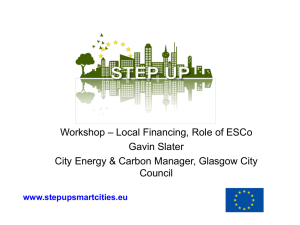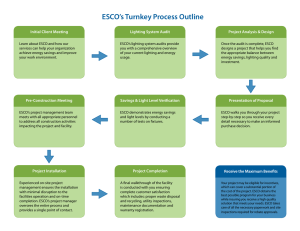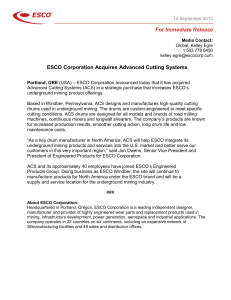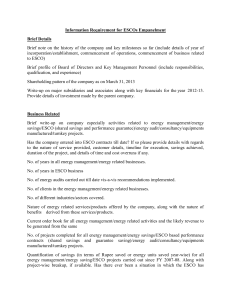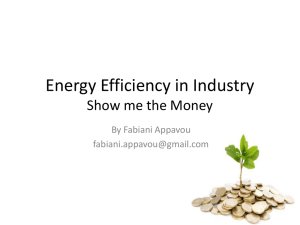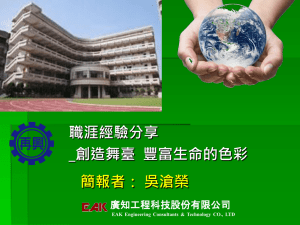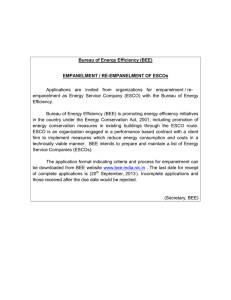Experiences with ESPC business models in Latvia´s
advertisement
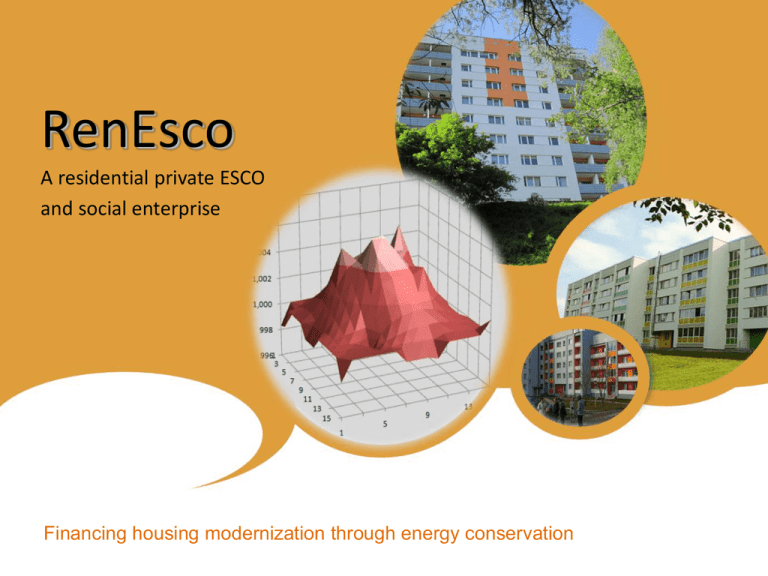
RenEsco A residential private ESCO and social enterprise Financing housing modernization through energy conservation External parts are corroding due to the effects of weather Crushed panel joints Collapsing structures Internal parts are poorly designed and rotting away Damaged roofs Obsolete engineering networks The question in Central/Easter Europe is not how to save energy! It is - how to save Eastern Europe’s housing stock? Energy saving is the answer. What has this Latvian residential ESCO done so far? • In 5 years Renesco 100% financed and performed deep renovations of 15 typical soviet-era apartment buildings using EPC’s. Bank provides 60% co-financing solely based on the EPC, no other collateral. Apartment owners have not, and will not, pay anything, nor assume any risks. • All investments are covered by future energy savings (20 years) and support from national renovation program (ERDF). • Measures: full building envelope, new hot water networks, new heating network, new ventilation recovery systems, cosmetic repairs, switching to renewables (geo-thermal). Before... and after Before... and after Staircase and entrance repair Windows and Doors Repair of balconies & loggias Heat distribution system Optimal thermo-insulation Thermo-limiters on radiators Dynamic balancing valves on risers Professional energy management (including monitoring) Domestic hot water system MIN number of risers Thermal insulation MIN pipe Ø DHW meters in staircases Reduction of circulation losses by 90+% Heating DHW If new DHW system installed Old ventilation system…. ‘natural’ ventilation • To little ventilation with poor indoor climate (fungus problems) • Ventilates not enough in mild weather conditions, too much in severe weather conditions • High heat losses (ventilation losses account for 30-50% of all heat losses in standard renovated buildings) …..new ventilation system mechanized ventilation • Fixed hourly air refresh independent of season or weather • Healthy indoor climate in all seasons and all parts of the apartments • Recovery of up to 90% of ventilated heat energy • If geothermal heat pump is installed > free cooling in summer Mechanical ventilation system with heat recovery (deep retrofit) Fixed hourly air refresh independent of season or weather Healthy indoor climate High efficient heat recovery Use of renewables and heat generation on site • Ground source heat pumps with vertical probes: No distribution losses Nothing is burned …… what has this Latvian residential ESCO done so far? • Probably the best cost/benefit ratio for renovations in the region. • Highest level of energy saving of non-pilot, bankable projects in the region. High customer satisfaction. 20 year guaranty on works. • Compared to other municipal and private projects, RENESCO’s projects have clearly proven to include much deeper measures at the same or lower costs, as well as better quality (documented study available) • Zero informal payments, clean and transparent process. Residents payment discipline is extraordinary! • While going through the roughest of crisis with unemployment skyrocketing, RENESCO has received 97% of payments on time, and 0% non-payment during its six years of existence. • All banks that we have spoken to in the region confirm extremely low default rates (if any) for renovated apartment buildings. • This can be explained by the explicit and unbreakable connection between apartment ownership and the heating and maintenance bills. There is no virtually no rental stock in Eastern Europe. 97% is owner-occupied. Though many owners are poor, nobody wants to lose their nicely renovated flat because of some utility bill. This is typical Post-Soviet legacy. Benefits for residents • Conservation and modernization of their apartment • The sales’ value of their apartment increases by about 20-40% right after renovation • More comfortable and nicer looking house to live in (currently many apartments are severely under-heated). • Flat owners receive 25% profit share of Renesco’s net result • 20 year guaranty on all construction works and therefor less worries and cost for maintenance during the contract period • After 20 years apartment owners get all the benefits from energy savings (expected 50-80%) • Flat owners do not assume any risk, or contribute in any form, except by agreeing that the energy savings will go to Renesco during the EPC period (20 years). This allows Renesco to take all investment decisions and innovate and learn. Esco’s cashflow from a financier’s perspective From an economic point of view RENESCO should be seen as a utility company with customers which; a) Are locked in for 20 years b) Will consume and pay for a guaranteed quantity of energy for 20 years c) Have provided a minimum price guarantee for that energy which exceeds operational costs and debt obligations The price the ESCO has paid to get these customers is the deep renovation of their building and a 20 guarantee on comfort and construction. If the country continuous to be governed by rule of law, there is no legal scenario under which an ESCO SPV holding the completed projects could end up with a negative cash flow Real or Perceived risks from RENESCO’s experience Barrier/Risk Type Perceived barrier Real or Red Herring? Performance Low and medium income people have to pay the bills. Many will not be able to. Proven Red Herring. Banks love to talk this up in order to increase the interest rates they can charge, or collect extra guarantees from governments. Expected energy savings will not be achieved, or will drop after some years of performance Proven Red Herring. Thousands of similar buildings. Expected savings usually within 25% range of error. They do not decrease over time. Lack of consistent policy. Start Stopping of programs Major problem. It takes 1-2 years to develop projects, 3-5 years to develop capable organizations. Stopping programs destroys projects and renovation companies Transaction costs. Complexity of support programs. Procurement rules. Real. Consumes at least 70% of RENESCO staff time. Adds 10-15% to the total project costs. Creates many unnecessary risks an project failures. Leads to stupid decisions. No financing available. Subsidy yes, finance no. Especially problem for small private sector Real. Many approved projects cancelled because lack of finance. 1% lower interest = 9% investment subsidy. ESCO cost of capital is much to high (~7%) Policy Received price from Commissioner Oettinger European Energy Service Award 2011 Award Winners 2011 Best Provider: RENESCO The prize was organized by the Berlin Energy Agency. The jury consisted of the European Commission European Investment Bank European Bank for Reconstruction and Development European Federation of Regional Energy and Environment Agencies German Federal Environment Agency Current finance situation for RENESCO in Latvia (not good) • Term bank loans max 15 years (EPC’s are 20 years) • Cost of finance 6-7% net • Equity requirement of 42% from local bank! • Refinancing of completed and well performing projects; not • National renovation program stopped since one year threatening the organizational continuity of the ESCO. Waiting for new program. Responsible ministry has insufficient capacity to design good new program. Latvia is not unique in this. • It seems half of the approved projects (1440) from previous national renovation program will not be implemented because bank funding could not be secured. Percentage increased in recent years. • Discussion with EBRD and other IFI’s for many years on ESCO finance, now looking at a creating a forfeiting fund to buy up ESCO cashflows . While waiting for decisions from responsible institutions Renesco has had to cancel many projects at great financial cost. RENESCO has run out of equity. • Result of all above; this ‘successful’ private sector residential ESCO is imploding do to lack of suitable finance while waiting for policy-makers to make policy, and financial institutions to do finance. RENESCO’s experience in finding workable programs and finance • In the last 2007-2013 period many countries had loan and subsidy programs which excluded third parties such as ESCO as borrower or grant receiver. The EC and IFI’s went along with this, preventing ESCO’s or any other third parties to develop. Often vested interests have and are being served. This should stop. • De biggest barrier in implementing EE in residential buildings does not originate from the practice on the ground; the realization of energy savings and collection of these savings. Instead it originates mainly from the lack of consistent policies from governments and financial institutions to realistically deal with the post -soviet housing legacy. • Local and international financial institutions let themselves get distracted by endless discussion regarding perceived project development and credit risks and disregard good proven practice. Instead they should focus on solving the real bottlenecks which are often self-made. Thank you for attention! RENESCO Eric Berman www.renesco.lv +371 29707212 eric@berman.nl
